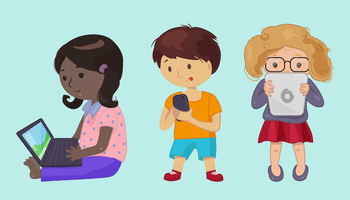
The online world is a cornucopia of information and its importance is such that, in the literal meaning of the phrase, we cannot imagine a world without it. The infinite cyberworld is overflowing with information starting from fun and games to education.
As an educationist and a mother, I do not want to fear this wonderland of mass information and neither do parents. But in our hopes for blissful ignorance, we cannot ignore the fact that the online world has many dangers lurking around the corner and it is imperative that we help the children navigate this maze safely and securely.
In the digital era, it is difficult to point out exactly when children are not exposed to the internet. Starting from parents using their digital devices to feed their months old babies to adults using them during leisure and work, I think it’s safe to say that this generation is being reared online.
We can argue till we can no longer breathe but we cannot deny that just taking them off the internet is no solution. What is important is that we, parents and the school collectively, equip them to remain safe and secure from the dangers that lurk online.
According to a study, 9 in 10 children 7- to 12-years-old have access to the internet, globally. Parents allow these devices despite the risks of their child being exposed to violent and inappropriate content. There is no blame there as the internet has crept up everywhere and is indispensable when it comes to school, work and keeping in touch with friends. Despite being countless pros, sometimes the cons outweigh them, like cyberbullying, internet theft and so much more.
While the aforementioned incidents are bound to leave a child psychologically scarred, something we as parents try to prevent actively, there is a completely different side to the cyber world that’s right in front of our eyes but we miss. At the risk of repeating myself, the internet is a cornucopia of information and as we all know, information has great power to influence.
More often than not, the online world is filled with content that influences the decoder to conform to body image standards and subjects them to bullying that not only leaves an individual with self-esteem issues and dissatisfaction but also leaves lasting psychological damage.
The psychological damage to a child is not the only thing unsafe and unsupervised internet inflicts on a child. There have been countless instances of credit card theft and children spending thousands without parents’ knowledge. As adults, it is up to us to police and supervise our child’s experience but we must do it in a way that they know how to protect themselves without us constantly breathing down their necks.
The first step to helping them is to educate ourselves. Often in our country parents themselves do not have proper knowledge of the workings of the internet. Before we protect the children, we must know how to battle the monsters ourselves. A study shows that an average parent throughout the course of their offspring’s childhood spend only 46 minutes on a talk on internet safety as opposed to all the time spent on trying to help them learn a new skill.
Parents must approach the online world the same way as the physical world. This is where cybersecurity comes into play. They must track the child’s online behaviour and have open discussions about them. One of the best ways to track is deploying security software tools, a technology that allows you to monitor the child’s screen-time among many other things including blocking adult websites.
However, by no means does it mean that you can dispose of face to face communication that will help you find out whether your child is being bullied or falling victim to predators. Another way to keep track of the activities is that you leave the devices out in the open which will also cause the kids to self-check. In addition to that limit the screen time but make sure you negotiate it with them so they know that their opinions are valued.
However, it is naïve to think that we can always be there with our children when they are surfing the internet. Educate your child to block and report any problematic or disturbing content as well as being responsible and fact-checking the information they share on their social media platforms. Teach them the impact and consequences of sharing information and how it can get them into hot water or embarrass them in the future.
Another issue that we take lightly is the lack of privacy. Educate your child on the dangers of data leak and hackers stealing credentials and teach them to not only have strong, unique passwords for each of their platforms but to also change them from time to time. With the rising number of security breaches being reported every day, it’s important our children are aware of how much information should be shared online.
In addition to that make them aware of insecure Wi-Fi connections. While we jump, we joy at the restaurants and malls having free Wi-Fi, hackers lurk to steal information that’s entered as the connection isn’t encrypted. If they must use the free internet access, teach them to do so after establishing a virtual private network (VPN) connection. Parents must recognize the different types of cyber-crimes that children can come across, like password attacks, malware, phishing, pharming, etc. If parents are well aware of these crimes, supervision will become much more efficient.
Let us discuss the common cyber issues that people might face and how to solve them:
1. Password attacks
An attempt to obtain or crack a user’s password for illegal use. Hackers can use crackling programs, dictionary attacks, and password sniffers in password attacks. Defense against password attacks is rather limited but usually consists of a password policy including a minimum length, unrecognizable words, and frequent changes.
2. Malware
Malware is one of the most common cyber issues that people face. Malware is software designed to cause damage to computers and other devices. Computer viruses and spyware are such malware that frequently attack systems. In order to avoid this, children must be educated to not click any suspicious links and study and make sure that they are not in a counterfeit site as malware is usually disguised in these forms. Updating the computer’s firewall and antiviruses regularly is an easy way to prevent this software from getting into the system.
3. Phishing
Phishing is a scam to obtain sensitive information through emails. While an email account is indispensable, when it comes to opening an account, often phishing scams lead to not only information being compromised but also money. Sometimes, harmless-looking emails with URLs or links that direct the surfer to another website are just traps. Make sure your child knows not to disclose credit information or any personal information in these links and delete them immediately without opening.
In addition to that, also teach a child to do the following:
* They should not disclose their identity to strangers without much information
* They must never hack into anyone’s account or use their information to create duplicate accounts as it is a punishable offense and can lead to jail time.
* Before sharing pictures on social media platforms, they must give proper privacy settings to prevent hackers from getting access to them.
* Whenever they face any sort of hacking issue, they should immediately report their parents about this and even the police if it is too extreme.
As parents and teachers, it’s our duty to teach our child proper etiquette and keep them safe and secure in the unpredictable cyber world. Once they know how to navigate the internet safely and securely, they can enjoy its benefits without lasting psychological trauma and compromising their information. Thus Siddiqui’s International School is organizing awareness programs in collaboration with Dr. Khaled Khan, an academician and researcher in cybersecurity at Qatar University, to educate the children about all these so that they are able to tackle them on their own.





